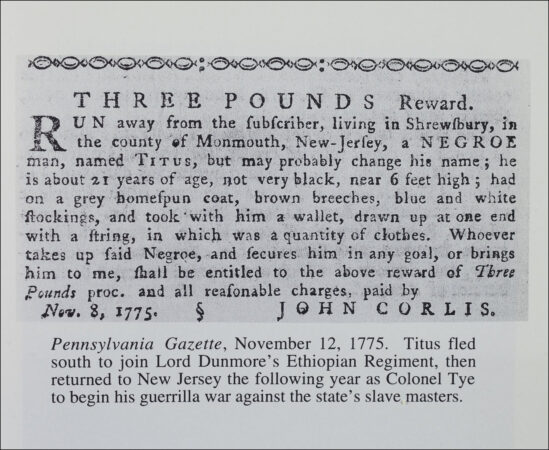
December 29, 1675
How Enslavement Came to Monmouth County
Editor's note: On December 29, 1675, the entrepreneur Lewis Morris purchased a one-half interest in a bog iron property in Monmouth County near Colts Neck. He built an iron forge on the river in what today is Tinton Falls, and

November 8, 1775
A Timeline of the Escaped Slave Titus who Became the Dreaded Loyalist Raider Colonel Tye
On November 8, 1775, a 22-year-old slave named Titus ran away from his owner and master, John Corlies of Colts Neck. Corlies was a Quaker who did not agree with Monmouth County Quaker views on the handling of slaves. Quakers during

November 15, 1775
Titus Becomes Tye in Lord Dunmore’s Ethiopian Regiment of Black Loyalist Soldiers
On November 15, 1775, the former Colts Neck slave named Titus, now calling himself simply "Tye," took part in the first armed conflict in American history involving an organized unit of African American soldiers. But they were fighting for the

October 27, 1778
Joshua Huddy, Innkeeper
On October 27, 1778, Huddy married Catherine Applegate Hart, the widow of Levy Hart, a Jewish tavern keeper in Colts Neck who had died in 1775. Although Protestants, Catherine Applegate and her sister Hannah both married prosperous Jews in Monmouth

September 1, 1780
The Fatal Showdown Between Colonel Tye and Joshua Huddy
Original illustration exclusively for Monmouth Timeline, ©2021 by Charles Swerdlow, all rights reserved. In the years following the Battle of Monmouth, residents of Monmouth County engaged in an escalating civil war between residents siding with the Revolutionary cause, and residents

September 10, 1854
Experimental Utopian Communities: The North American Phalanx
On September 10, 1854, a fire swept through the North American Phalanx, destroying its vital mill, ending the experiment in secular utopian socialist commune life. [caption id="attachment_1616" align="aligncenter" width="1280"] Exterior view of the main residential edifice of the North

March 5, 1886
Samuel Johnson, Victim of a Lynching
Thousands of Black people were the victims of racial terror lynching in the United States between 1865 and 1950, including hundreds of lynchings that took place outside the South. Violent resistance to equal rights for African Americans led to fatal

December 13, 1943
Naval Weapons Station Earle
On December 13, 1943, Naval Ammunition Depot Earle was commissioned. The facility, which sits on 11,000 acres in Monmouth County, was designed to provide for the safe and secure storage and transfer of ordnance – bombs, bullets, missiles, torpedoes, depth

